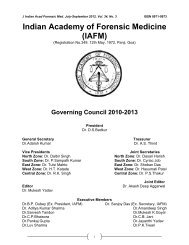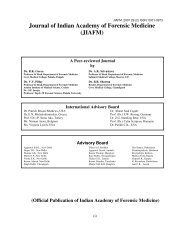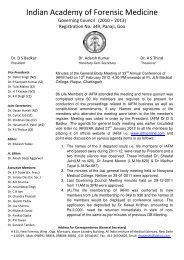Indian Academy of Forensic Medicine (IAFM) - Official website of IAFM
Indian Academy of Forensic Medicine (IAFM) - Official website of IAFM
Indian Academy of Forensic Medicine (IAFM) - Official website of IAFM
You also want an ePaper? Increase the reach of your titles
YUMPU automatically turns print PDFs into web optimized ePapers that Google loves.
J <strong>Indian</strong> Acad <strong>Forensic</strong> Med. Jan- March 2012, Vol. 34, No. 1 ISSN 0971-0973<br />
height was more in males and this difference<br />
was statistically significant. This finding is in<br />
congruence with the observations <strong>of</strong><br />
investigators on European sample. [6, 7]<br />
The sciatic notch width in the present<br />
series were comparable with those from a North<br />
<strong>Indian</strong> study [10] that showed the mean width for<br />
males was 4.49cm (standard deviation 0.44) and<br />
for females it was 4.84 cm (standard deviation <strong>of</strong><br />
.48)The sciatic notch width is significantly<br />
different in the two sexes. The sciatic notch is<br />
rather a better indicator <strong>of</strong> sex in the hipbone as<br />
has been postulated by earlier workers. [8, 9,<br />
10, 11] In the present study a new rule <strong>of</strong> thumb<br />
was formulated on the basis <strong>of</strong> the sectioning<br />
point and the standard deviation <strong>of</strong> the values <strong>of</strong><br />
the index in the two sexes. On applying this rule<br />
93.3% <strong>of</strong> the bones could be correctly assigned<br />
to its proper sex. These results are better than<br />
the Kelley’s approach when applied to the <strong>Indian</strong><br />
Bengali sample. Thus the present investigation<br />
clearly showed that the sciatic notch /acetabular<br />
height index is a good method <strong>of</strong> sexing human<br />
hipbones in <strong>Indian</strong>s when the new rule is<br />
applied. This will be equally effective even in<br />
fragmentary remains as the index can be easily<br />
calculated by measuring the two variables.<br />
This method has one shortcoming that<br />
had also been highlighted by Kelley. The main<br />
difficulty lies with defining the exact anatomical<br />
landmark for the measurements and the effects<br />
<strong>of</strong> wear and destruction <strong>of</strong> the bony points in<br />
bones that are obtained for forensic casework.<br />
Also the chances <strong>of</strong> inter-observer variations<br />
could not be tested in this series, as it was a<br />
single author work. However in the present<br />
series a standard protocol [10, 11] was followed<br />
for the measurement that has been described in<br />
the method section.<br />
Besides the present work is a<br />
preliminary study as the sample comprised thirty<br />
fully ossified human bones belonging to the<br />
<strong>Indian</strong> Bengali population. Given the diversity <strong>of</strong><br />
the <strong>Indian</strong> population and the results <strong>of</strong> earlier<br />
works [12], such a small sample size is not at all<br />
effective in providing results that can be<br />
generalized. This approach need to be further<br />
worked out with a larger sample preferably in a<br />
multicentric study. There is also ample scope to<br />
examine the regional variation in <strong>Indian</strong> bones<br />
and its applicability in sexing skeletal remains.<br />
It is concluded that the present new rule<br />
<strong>of</strong> thumb approach is a valid, effective, reliable,<br />
population specific and easy method to<br />
differentiate between male and female pelvis in<br />
<strong>Indian</strong> Bengali skeletal remains. This will have<br />
useful application in anthropology, archaeology<br />
and <strong>Forensic</strong> casework involving unidentified<br />
29<br />
human remains belonging, the <strong>Indian</strong> Bengali<br />
population.<br />
References:<br />
1. W.M. Krogman, M.Y. İşcan. The Human Skeleton in <strong>Forensic</strong><br />
<strong>Medicine</strong>, Charles C. Thomas, Springfield, IL, 1986: 202-08.<br />
2. Bruzek J. A method for visual determination <strong>of</strong> sex, using the<br />
human hipbone, Am. J. Phys. Anthropol. 2002; 117: 157-68.<br />
3. MacLaughlin S.M, Bruce M.F. Sex determination from the pelvis in<br />
a Dutch skeletal series, J. Anat. 1985; 140: 532.<br />
4. Albanese J. A metric method for sex determination using the<br />
hipbone and the femur, J. <strong>Forensic</strong> Sci. 2003; 48 (2): 263-73.<br />
5. DiBennardo R, Taylor J.V. Multiple discriminant function analysis<br />
<strong>of</strong> sex and race in the postcranial skeleton, Am. J. Phys. Anthropol.<br />
1983; 61: 305-14.<br />
6. Kelley M.A. Sex determination with fragmented skeletal remains, J.<br />
<strong>Forensic</strong> Sci. 1979; 24(1): 154-58.<br />
7. MacLaughlin S.M, Bruce M.F. The sciatic notch/acetabular index<br />
as a discriminator <strong>of</strong> sex in European skeletal remains. J.<strong>Forensic</strong><br />
Sci 1986; 31(4): 1380-90.<br />
8. Walker P.L. Greater sciatic notch morphology: Sex, age, and<br />
population differences, Am. J. Phys. Anthropology. 2005; 127 (4):<br />
385-91.<br />
9. Milne N. Sexing <strong>of</strong> human hip bones J. Anat. 1990; 172: 221-26.<br />
10. Singh S, Potturi B.R. Greater sciatic notch in sex determination J.<br />
Anatomy 1978; 125: 619-22.<br />
11. Kalsey G, Singla R .K, Sachdeva K. Role <strong>of</strong> the greater sciatic<br />
notch <strong>of</strong> the hip bone in sexual dimorphism: a morphometric study<br />
<strong>of</strong> the North <strong>Indian</strong> population Med Sci Law 2011; 51(2): 81–86.<br />
12. Nagesha K.R., Kanchana T, Bastiab B K. Sexual dimorphism <strong>of</strong><br />
acetabulum–pubis index in South-<strong>Indian</strong> population Legal <strong>Medicine</strong><br />
2007; 9(6): 305-08.<br />
Table 1A: Showing summary statistics<br />
SEX Statistic<br />
SCIATICN Male Mean 4.3929<br />
Std. Deviation .3050<br />
Minimum 4.00<br />
Maximum 5.30<br />
Female Mean 4.9125<br />
Std. Deviation .2778<br />
Minimum 4.50<br />
Maximum 5.30<br />
Range .80<br />
ACETABUH Male Mean 5.2929<br />
Std. Deviation .1817<br />
Minimum 5.00<br />
Maximum 5.60<br />
Range .60<br />
Female Mean 4.8000<br />
Std. Deviation .2033<br />
Minimum 4.40<br />
Maximum 5.10<br />
Range .70<br />
KELLYS Male Mean .8317<br />
Std. Deviation 7.785E-02<br />
Minimum .77<br />
Maximum 1.06<br />
Range .29<br />
Female Mean 1.0237<br />
Std. Deviation 4.511E-02<br />
Minimum .94<br />
Maximum 1.10<br />
Range .17<br />
Table1: Descriptive Statistics <strong>of</strong> the Variables<br />
N Minimum Maximum Mean Std.<br />
Deviation<br />
KELLYS 30 .77 1.10 .9341 .1151<br />
SCIATICN 30 4.00 5.30 4.6700 .3888<br />
ACETABUH 30 4.40 5.60 5.0300 .3142









